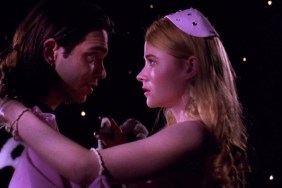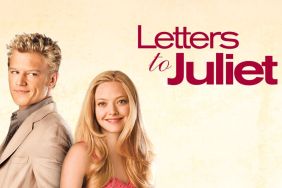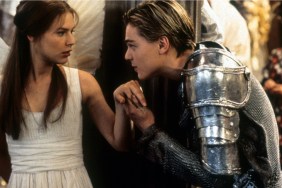Cast:
James McAvoy as Gnomeo
Emily Blunt as Juliet
Ashley Jensen as Nanette
Michael Caine as Lord Redbrick
Matt Lucas as Benny
Jim Cummings as Featherstone
Maggie Smith as Lady Bluebury
Jason Statham as Tybalt
Ozzy Osbourne as Fawn
Stephen Merchant as Paris
Patrick Stewart as Bill Shakespeare
Julie Walters as Miss Montague
Hulk Hogan as Terrafirminator V.O.
Story:
A bizarre retelling of William Shakespeare’s “Romeo and Juliet” finds a war between the lawns of two houses and the red and blue garden gnomes that live within. When one adventurer, Gnomeo (James McAvoy), meets and falls for the rival lawn’s Juliet (Emily Blunt), the two star-crossed lovers attempt to overcome both the dictates of a society that would keep them apart and the overall artistic fate that demands their story end in tragedy.
Analysis:
“Gnomeo & Juliet” works quite wonderfully as what it appears to be on the surface: a bright and colorful adaptation of one of the world’s most famous stories, filtered through modern pop sensibilities. While clearly aimed at children, the film is littered with both references to other Shakespearean works and so-bad-they’re-hilarious puns (many times one and the same). From the first frames, “Gnomeo” delivers its sense of humor without apology and winds up as Disney’s most offbeat and laugh-out-loud film since 2002’s “Lilo & Stitch.” What’s happening beneath the surface, though, makes for more than escapist fun; “Gnomeo & Juliet” also serves as a smart tribute to camp and, as such, carries some clever, subversive comments on modern society.
Notoriously hard to define, camp sensibilities were most famously analyzed in a 1964 essay by Susan Sontag entitled “Notes on Camp,” positing that “bad” art has a social relevance in eliminating gender barriers and offering an appreciation for aesthetics that go beyond the standard, particularly as a forum for the (at the time even moreso) “taboo” of homosexuality. In “Gnomeo,” we’re treated to a celebration of kitsch in the form of garden gnomes, backed throughout by the music of Elton John. A celebration of theatrical flamboyancy, “Gnomeo & Juliet” plays sort of as if “Hairspray”-era John Waters directed “Toy Story.”
“It is not a natural mode of sensibility,” Sontag writes, “if there be any such. Indeed the essence of Camp is its love of the unnatural: of artifice and exaggeration. And Camp is esoteric — something of a private code, a badge of identity even, among small urban cliques.”
The un-nature of “Gnomeo” is most clearly evident in the film’s leading characters, being garish sculptures themselves (also recalling Sontag’s connection of camp objects to William Empson’s “urban pastoral”). These are anthropomorphized decorations, inhabiting an environment built entirely out of aestheticism, but framed against an upper class London “reality,” exactly the kind of environment where camp is said to thrive. Added to the mix are all manner of “low art” cameos, in the form Ozzy Osbourne, Katy Perry and Hulk Hogan, cleverly framed against the “high art” of William Shakespeare.
Most interesting is the role of Featherstone (as played by Jim Cummings), a flamboyant pink flamingo who comes very close to being Disney’s first openly gay character. When he learns of the Capulet/Montague conflict between Red and Blue gnomes (which, itself, is not hard to see as a modern comment on American politics), he responds with, “Red and blue? Who cares? I’m pink!” before relating a story wherein his significant other (another lawn flamingo) is taken away because his two owners split up.
“Other people’s hate,” he says in a perfect Prop 8 parallel, “Ruined my love.”
Admittedly, the other flamingo (who never speaks) is depicted with eyelashes and, as such, a hint of femininity, but whether that is due to over-sensitivity or not is a moot point as another key aspect of camp is, as Sontag says, “the triumph of the epicene style”. That is, the stripping of gender roles in the first place. Instead of male and female, we’re assigning identities to genderless objects. If fiction can be used to define equality in a vacuum (justifying, here, the love of two garden gnomes, for instance) there’s no reason that same morality can’t represent itself in reality. It’s a smart bit of storytelling that drives exactly what was at the political heart of the original play.
Likewise, lack of reality is another one of the central elements of camp and something that “Gnomeo & Juliet” embraces in some fantastic ways. By retelling history’s greatest fictional tragedy, the film gives us characters who become acutely aware of their own fates and, in a truly inspired bit of post-modernism, are able to comment on the actual writing itself, never even breaking the fourth wall. The struggle of the lovers becomes more than defiance to the society established in the narrative; it’s now a struggle outside and against the narrative itself.
Of course, Sontag also surmises that “to talk about camp is therefore to betray it,” and, in some ways, to declare the film a cerebral triumph does a disservice to exactly how well the whole thing flies under the radar as a bright, colorful work of pop entertainment. Filled with an excellent voicework and wonderfully groan-inducing puns, “Gnomeo & Juliet” should delight all but the most hardened cynic.










